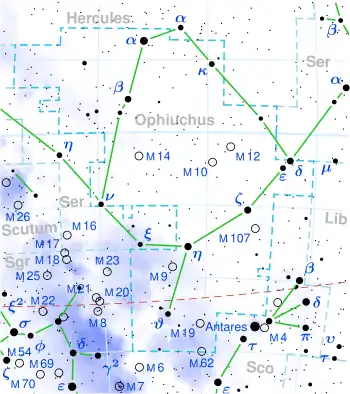 | |
| Observation data Epoch J2000 Equinox J2000 | |
|---|---|
| Constellation | Ophiuchus |
| Right ascension | 16h 31m 08.36732s[1] |
| Declination | −16° 36′ 45.8306″[1] |
| Apparent magnitude (V) | 4.27[2] |
| Characteristics | |
| Spectral type | G8+IIIa[3] |
| U−B color index | +0.71[2] |
| B−V color index | +0.92[2] |
| Astrometry | |
| Radial velocity (Rv) | –33.46[4] km/s |
| Proper motion (μ) | RA: –45.35[1] mas/yr Dec.: –37.34[1] mas/yr |
| Parallax (π) | 13.39 ± 0.24 mas[1] |
| Distance | 244 ± 4 ly (75 ± 1 pc) |
| Absolute magnitude (MV) | –0.08[5] |
| Details[6] | |
| Mass | 3.16±0.04 M☉ |
| Radius | 13.40±0.31 R☉ |
| Luminosity | 111.8±4.3 L☉ |
| Surface gravity (log g) | 2.72±0.02 cgs |
| Temperature | 5,131±32 K |
| Metallicity [Fe/H] | 0.16±0.10 dex |
| Rotational velocity (v sin i) | 3.6[7] km/s |
| Age | 330±10 Myr |
| Other designations | |
| Database references | |
| SIMBAD | data |
Phi Ophiuchi, a name Latinized from φ Ophiuchi, is a single[9] star in the equatorial constellation of Ophiuchus.[8] It has a yellow hue and is faintly visible to the naked eye with an apparent visual magnitude of 4.27.[2] The star is located at a distance of approximately 244 light-years from the Sun based on parallax,[1] but it is drifting closer with a radial velocity of −33.5 km/s.[4]
The stellar classification of Phi Opiuchi is G8+IIIa,[3] an evolved giant star that has exhausted the supply of hydrogen at its core. In 2000, D. R. Alves identified it as a red clump giant on the horizontal branch that is generating energy by core helium fusion.[10] However, S. Reffert and associates in 2015 instead placed it on the red-giant branch.[6] A 2018 study by S. Stock and associates used Bayesian estimates to arrive at a 94% chance the star is on the horizontal branch.[11]
The star is around 360[12] million years old with an estimated 3.16 times the mass of the Sun and 13.4 times the Sun's radius. It is radiating 112 times the luminosity of the Sun from its enlarged photosphere at an effective temperature of 5,131 K.[6]
It has two visual companions, component B, at magnitude 12.9 and separation 41.3", and component C, at magnitude 10.8 and separation 119.8".[13]
References
- 1 2 3 4 5 6 Van Leeuwen, F. (2007). "Validation of the new Hipparcos reduction". Astronomy and Astrophysics. 474 (2): 653–664. arXiv:0708.1752. Bibcode:2007A&A...474..653V. doi:10.1051/0004-6361:20078357. S2CID 18759600. Vizier catalog entry
- 1 2 3 4 Ducati, J. R. (2002). "VizieR Online Data Catalog: Catalogue of Stellar Photometry in Johnson's 11-color system". CDS/ADC Collection of Electronic Catalogues. 2237. Bibcode:2002yCat.2237....0D.
- 1 2 Keenan, Philip C.; McNeil, Raymond C. (1989). "The Perkins catalog of revised MK types for the cooler stars". Astrophysical Journal Supplement Series. 71: 245. Bibcode:1989ApJS...71..245K. doi:10.1086/191373.
- 1 2 Massarotti, Alessandro; et al. (2008). "Rotational and Radial Velocities for a Sample of 761 Hipparcos Giants and the Role of Binarity". The Astronomical Journal. 135 (1): 209–231. Bibcode:2008AJ....135..209M. doi:10.1088/0004-6256/135/1/209. S2CID 121883397.
- ↑ Anderson, E.; Francis, Ch. (2012). "XHIP: An extended hipparcos compilation". Astronomy Letters. 38 (5): 331. arXiv:1108.4971. Bibcode:2012AstL...38..331A. doi:10.1134/S1063773712050015. S2CID 119257644. Vizier catalog entry
- 1 2 3 Reffert, Sabine; et al. (2015). "Precise radial velocities of giant stars". Astronomy & Astrophysics. 574: A116. arXiv:1412.4634. Bibcode:2015A&A...574A.116R. doi:10.1051/0004-6361/201322360. hdl:10722/215277. S2CID 59334290. Vizier catalog entry
- ↑ De Medeiros, J. R.; et al. (2014). "A catalog of rotational and radial velocities for evolved stars". Astronomy & Astrophysics. 561: A126. arXiv:1312.3474. Bibcode:2014A&A...561A.126D. doi:10.1051/0004-6361/201220762. S2CID 54046583. Vizier catalog entry
- 1 2 "phi Oph". SIMBAD. Centre de données astronomiques de Strasbourg. Retrieved 2021-01-24.
- ↑ Eggleton, P. P.; Tokovinin, A. A. (September 2008). "A catalogue of multiplicity among bright stellar systems". Monthly Notices of the Royal Astronomical Society. 389 (2): 869–879. arXiv:0806.2878. Bibcode:2008MNRAS.389..869E. doi:10.1111/j.1365-2966.2008.13596.x. S2CID 14878976.
- ↑ Alves, David R. (August 2000), "K-Band Calibration of the Red Clump Luminosity", The Astrophysical Journal, 539 (2): 732–741, arXiv:astro-ph/0003329, Bibcode:2000ApJ...539..732A, doi:10.1086/309278, S2CID 16673121
- ↑ Stock, Stephan; et al. (August 2018), "Precise radial velocities of giant stars. X. Bayesian stellar parameters and evolutionary stages for 372 giant stars from the Lick planet search", Astronomy & Astrophysics, 616: 15, arXiv:1805.04094, Bibcode:2018A&A...616A..33S, doi:10.1051/0004-6361/201833111, S2CID 119361866, A33
- ↑ Luck, R. Earle (2015). "Abundances in the Local Region. I. G and K Giants". Astronomical Journal. 150 (3). 88. arXiv:1507.01466. Bibcode:2015AJ....150...88L. doi:10.1088/0004-6256/150/3/88. S2CID 118505114.
- ↑ Mason, Brian D.; et al. (2001). "The 2001 US Naval Observatory Double Star CD-ROM. I. The Washington Double Star Catalog". The Astronomical Journal. 122 (6): 3466. Bibcode:2001AJ....122.3466M. doi:10.1086/323920. Vizier catalog entry